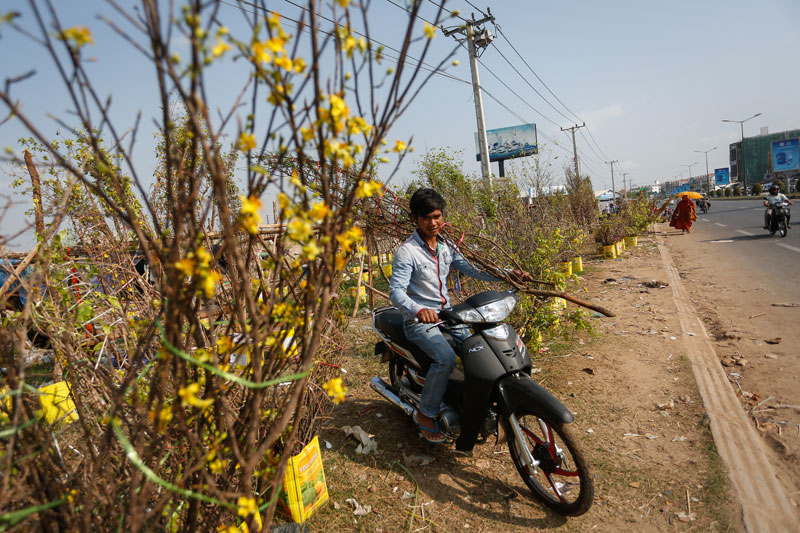In the lead-up to Chinese New Year, vendors lined the markets and streets of Phnom Penh touting “money trees,” or bundles of Angkea sil branches, which are believed to bring fortune to those celebrating the holiday.
But informal payments demanded of those involved in the seasonal business are pushing up the costs of locating and transporting the already scarce boughs—and consumers are footing the bill.

On Tuesday, 40-year-old Serey Ratanak spent about 20 minutes carefully examining the branches, leaves and buds of the Angkea sil for sale at Sen Sok district’s Phsar Deyhoy market before making his purchase to mark the Year of the Goat, which begins on Thursday.
“When we buy the branches, we should check to see whether the flowers will blossom on the day of Chinese New Year, as this will reflect our business situation throughout the year,” said Mr. Ratanak, who claims Chinese ancestry.
But in order for the money trees to reach the homes of those celebrating the first day of the Chinese lunar calendar, they must first be brought out of the mountains of Kampot, Kompong Speu, Kompong Chhnang and Pursat provinces.
Sok Khim, 44, a rice farmer in Kompong Speu’s Thpong district, has taken on seasonal work cutting Angkea sil branches since 2002.
Equipped with knives and axes, Mr. Khim and about 40 other cutters travel to the province’s Aural and Pich mountains—located on the eastern side of the Cardamom range—where they spend about eight hours a day searching dense terrain for the trees that produce them.
“It is very difficult to find the money trees because we have to go deep into the forests and I always feel afraid of the wildlife,” Mr. Khim said. “We experience injuries on our arms, legs and sometimes on our torsos.”
Besides the physical challenges the cutters face, he said, they are also forced to pay bribes.
“The places where we cut the branches of money trees are not protected areas, but we have to pass through the land of a private company, where we have to pay money. And sometimes the forest rangers don’t allow us to go inside if we don’t pay them,” he said.
According to Mr. Khim, he must budget $20 for payments to local Forestry Administration officials each year, as well as $15 for workers on a cassava and sugarcane plantation that he and his fellow cutters must cross.
He said he usually collects two or three bundles of branches per day that he can sell on to middlemen for between $5 and $7.50 per bunch.
In Phnom Penh, the price of Angkea sil bundles range from $15 to $150, depending on their size.
Sao Ny, 55, who buys bundles from Mr. Khim and resells them at Phsar Deyhoy, said she spent about $1,000 this year to purchase and transport 100 bundles, $250 of which was allocated for bribes.
“On the way back from the provinces, the police and forest rangers accused us of cutting the branches illegally and blocked us,” she said. “There are 10 checkpoints from Pursat and Kompong Speu to Phnom Penh, and at each one, we have to pay between 100,000 riel [about $25] and 1 million riel [about $250].”
Forestry Administration director Chheng Kimsun acknowledged that cutting the branches of money trees was not illegal.
“People cut money trees, which are considered a variety of small plant, and they just cut their branches, and don’t remove the whole plants by their roots,” he said.
Mr. Kimsun said, however, that middlemen who buy branches from local cutters to sell in cities such as Phnom Penh must obtain official permission to do so.
“If people cut the trees…for traditional use, there is no problem, but if someone buys the trees from them for commercial purposes, he or she has to request a permission letter from the relevant authority first. Otherwise, the action is illegal,” he said.
Yet Mr. Kimsun also conceded that in Pursat and Kompong Speu, some local Forestry Administration officials ask for bribes to allow cutters to enter the mountains, and extort middlemen operating without permission.
“Actually, not only local forestry officials but also journalists ask for money from local people who go into the forest and cut the trees, and also from traders who transport the trees,” he said.
“When they [Forestry Administration officials] fail to get the money from those people, sometimes they call me at night” to report illegal activity, he said. “But when they get the money, they keep quiet.”




